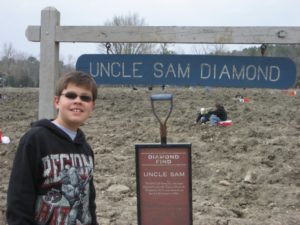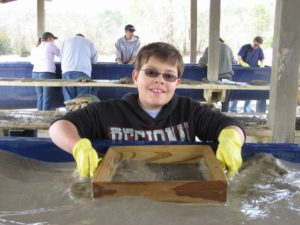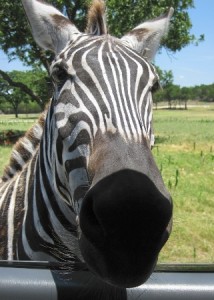 Prospectors, young and old, find treasures at Crater of the Diamonds State Park in Murfreesboro. The park is the only diamond mine open to the public – and the best part – you keep whatever you unearth.
Prospectors, young and old, find treasures at Crater of the Diamonds State Park in Murfreesboro. The park is the only diamond mine open to the public – and the best part – you keep whatever you unearth.
The Mine
Don’t be disappointed by your first glimpse at the diamond mine. Outwardly, it looks like a plowed farmer’s field. Appearances are deceiving. Hidden among the dirt furrows are diamond, agate, jasper, and quartz.
Diamond hunting can be surprisingly easy. Most gems found are small, about the size of a pea, and are less than a carat. The best diamond hunting is on a sunny day following a heavy rainstorm. The rain washes the dirt from the denser diamonds and the sunshine signals the hunter by reflecting off the diamond’s surface. In these conditions, diamonds can actually be found by simply walking the rows of plowed dirt.
Serious miners employ a more strenuous method to find their gems. Prospectors haul buckets filled with dirt to a washing area.  Park regulars use water to sluice dirt away from the stones and then sift through the remaining gravel in search of diamonds. With the right rhythm, the dense diamonds settle to the sluicing pan’s bottom separating out from the washed away dirt. This is hard work but fun to try. The park has two covered washing sheds for water sifting. It’s a lively place with fellow diamond hunters readily helping each other by offering tips and assistance to novice treasure seekers.
Park regulars use water to sluice dirt away from the stones and then sift through the remaining gravel in search of diamonds. With the right rhythm, the dense diamonds settle to the sluicing pan’s bottom separating out from the washed away dirt. This is hard work but fun to try. The park has two covered washing sheds for water sifting. It’s a lively place with fellow diamond hunters readily helping each other by offering tips and assistance to novice treasure seekers.
Some diamond hunters use a third method to find the elusive stones. Divining a likely spot, they plop down in the field and dry sift the soil. This method appears to be most fun for the youngest treasure seekers. Kids love to dig and here they are in their element.
Geology and history
How did diamonds end up in this Arkansas field? About 100 million years ago, a volcanic pipe shot diamonds and other geological wonders from deep within the earth’s mantle to the surface forming the Prairie Creek Diatreme. Traveling at speeds from 60 to 250 miles an hour, volcanic pipes pushed earth up and out to the surface, mixing magma with rock and minerals in its path.
At Crater of the Diamonds, the diamonds lost 60 to 80 percent of their size during their trip through the earth’s crust when they mixed with the hot, molten magma. Still, over the years there have been incredible finds. Discovered in 1924, the Uncle Sam diamond registered 40 carats. And in 1975, Mr. Johnson unearthed a 16 carat diamond, the Amarillo Starlight.
The first diamonds were discovered by John Huddleston, a local farmer in 1906. Commercial attempts to mine the diamonds did not succeed and in 1972 the State of Arkansas bought the property for a park. Since that time, over 2.8 million people visited and left with about 28,700 diamonds – that is roughly 600 diamonds a year. Not bad odds for treasure seekers.
More than diamonds
Even without a diamond, families can return home with treasures. Huge Jasper chunks litter the mine field with spots of red and burnished orange color. Lamproite with gold streaks of mica and translucent agate wait to be discovered. Visitors can remove one, five-gallon bucket of rock and soil each day. Following several visits to the Crater of the Diamonds, our family has an astoundingly colorful rock collection of personal finds.
Planning your visit
The park website offers tips for planning your mining expedition. Recommend wearing old clothes and boots as the field is often muddy. If you intend to wet sift for diamonds, bring rubber gloves. The park rents prospecting gear like sifting screens and hand trowels for a nominal fee. I suggest, however, that you bring your own bucket for transporting treasures home. Sandwich baggies are handy for keeping small stones from getting lost. Without shade trees, hats and sun screen are a must during summer months.
When you go
Crater of the Diamonds State Park (209 State Park Road, Murfreesboro) is open daily, with times varying by season. Entrance to the park is free, but there is a fee to access the diamond field. The park has tent and RV camping spots. The Queen of Diamonds Inn, located in nearby Murfreesboro, offers clean and comfortable rooms, or travel to either nearby Hope or Akadelphia for a wider selection of lodging.
So pack the kids and head out for a weekend treasure hunt. Maybe you will be next to discover a diamond.

